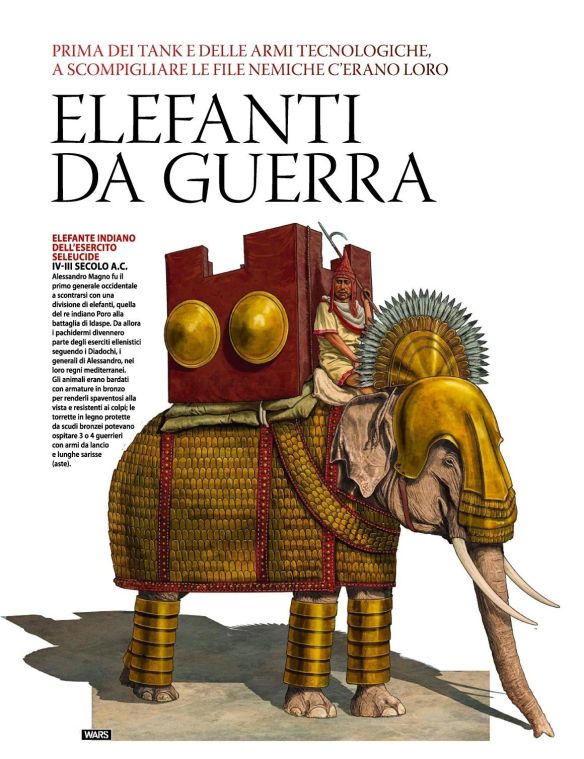Carthaginian
Hannibal used African battle elephants both to anchor his lines and to launch, along with heavy and light cavalry, combined-arms shock assaults to disorient and defeat the enemy on his front and rear. It has been argued that Hannibal also used his elephants along his route of march to impress and frighten European tribes to join his army.
Military Use of Elephants in the Greek and Roman Period
Parthia and Sassanian Persia
Another form of cavalry used in wars were the elephant corps. Ammianus Marcellinus described the elephants as having awful figures and savage, gaping mouths. They looked like walking towers and scarcely could be endured by the faint-hearted. According to Muslim historians, elephants were used as early as the third century c. e. by the Sassanians, who used them to raze such cities as Hatra. Sassanian king Peroz I (r. 457/459-484 c. e.) used fifty elephants in his campaign against the Ephthalites in the fifth century. Elephants were again used against the Arabs in the seventh century.
Delhi Sultanate
The backbones of the Delhi Sultan’s army were cavalry and war elephants, the latter adopted from the Hindus. The effect of one elephant in battle was equal to that of 500 horsemen.
Military tactics were heavily governed by the Artharva Veda (1500-1200 b. c. e.), one of the sacred writings of Hinduism. Archers shot from a kneeling position supported by spear, javelin, and shield- wielding infantry. Such immobility opened the army to ravaging attacks by extremely mobile Muslim and Mongol troops skilled in fighting on horseback. Elephants generally carried a driver, or mahout, and three to four warriors. In response, the use of large caltrops, iron-pointed triangular devices set in the ground to impede elephant and cavalry advances, was developed. Such Indian tactics were old-fashioned by the tenth century, but they continued into the thirteenth. Hindu pride prevented leaders from learning from their foreign adversaries. Hindus valued strength in numbers over speed and mobility, a doctrine that rapidly caused their defeat.
Indian armies relied on the use of war elephants, which served a similar purpose to tanks in modern warfare. Elephants could push forward large guns, carry the commander into battle, act as a battering ram against a fort, or crush opposing infantry under- foot by rushing into the ranks. Equipped with an iron chain in its trunk and taught to wield it in all directions, an elephant could wreak havoc against an enemy force. Although these great animals were impressive and could frighten an enemy, they were also unpredictable and could retreat under attack into the ranks of panicked Indian foot soldiers. Frequently commanders rode on the elephants so that they had the best view of the battlefield; this high perch made the commanders prime targets for enemy arrows. If the commander was wounded, or if he felt the need to descend from the howda on top of his elephant, his troops often assumed that he was dead and scattered.
Khmer
As a result of the Indian influence, elephants were used in battle and the King of Funan was reported as riding on an elephant as early as 245 c. e. Gradually more elephants were used in battle; one division of the army consisted of one hundred elephants, and a hundred men surrounded each elephant. In Cambodia, by the eleventh century, there was a sort of cage, called a howdah, on the back of the elephant. In it rode four men armed with bows, arrows, and lances. The elephant’s tusks might also be sharpened or lengthened with sword blades, and it might pick up enemy soldiers with its trunk or trample them underfoot. The standard battlefield role of war elephants was in the assault, to break up the enemy ranks, but elephants were also used in sieges, to push over gates and palisades or to serve as living bridges.
As well as fighting on land, the Khmers and the Chams also fought at sea. They used galleys to attack each other, and the Chinese also launched a seaborne invasion of Champa. This was notable because the Chinese introduced artillery to overcome the Cham elephant attacks. After the Chinese had landed, they directed all their arrow fire against the Cham elephants and subsequently obtained victory. The ballista, first used by the Chams, also became incorporated into the Khmer equipment.
